Stem cells could lead to future fertility treatments, study says
- Share via
In a long-sought achievement, Japanese researchers have demonstrated in mice that both eggs and sperm can be grown from stem cells and combined to produce healthy offspring, pointing the way to a new avenue for fertility treatments.
If the milestone accomplishment can be repeated in humans -- and experts said they are optimistic that such efforts will ultimately succeed -- the technique could make it easier for women in their 30s or 40s to become mothers. It could also help men and women whose reproductive organs have been damaged by cancer treatments or other causes.
About 10% of American women of childbearing age have trouble becoming or staying pregnant, and more than one-third of infertile couples must contend with a medical problem related to the prospective father, according to the U.S. Centers for Disease Control and Prevention in Atlanta.
Using current technology, only about one-third of attempts at assisted reproduction result in live births, CDC data show. Scientists, doctors and patients would like to boost that percentage.
“These studies provide that next level of evidence that in the future fertility could be managed with stem cell intervention,” said Teresa Woodruff, chief of fertility preservation at Northwestern University’s Feinberg School of Medicine.
The prospect of using stem cells to grow new eggs is particularly tantalizing, because women are born with a set amount and don’t make more once they are lost. In a sense, the therapy would allow them to turn back their biological clocks, said Stanford stem cell researcher Renee A. Reijo Pera, who studies reproduction.
“This is a get-them-back strategy,” she said.
Using stem cells to create sperm and eggs in mice is a feat researchers have attempted, without much success, for more than a decade, said Dr. George Q. Daley, a leading stem cell researcher at Children’s Hospital in Boston.
Dr. Mitinori Saitou and colleagues at Kyoto University detailed how they generated the functional mouse eggs in a report published online Thursday by the journal Science. Last year, the researchers reported in the journal Cell that they had done the same thing with mouse sperm.
In both cases, the team started with embryonic stem cells, which have the potential to develop into all of the different types of cells in the body. The scientists exposed the embryonic stem cells to stimuli that coaxed them to become egg and sperm precursors.
To get those precursors to develop into sperm, the researchers implanted them into the testes of infertile mice. Those mice ultimately fathered fertile, healthy pups through in vitro fertilization.
Generating eggs required a slightly different approach. Unlike sperm, viable eggs must provide genetic material as well as additional factors to support embryonic development. So the team carefully combined the egg precursors with embryonic ovarian cells in a dish. The resulting “reconstituted ovaries” were then transplanted into immuno-deficient mice, Saitou said.
After four weeks, the scientists removed the reconstituted ovaries and isolated eggs for in vitro fertilization. The embryos were implanted into surrogate mothers.
The pups from the stem-cell-generated eggs “look normal,” Saitou said. But he noted that it was “entirely possible that they have subtle abnormalities” that had not yet been identified.
Saitou and his colleagues were also able to spawn mouse pups starting from induced pluripotent stem cells, which are created when scientists rewind mature cells into an embryo-like state.
These cells are particularly interesting to scientists who study human fertility because they would provide a way to get DNA from a patient -- perhaps a young person who is undergoing fertility-damaging treatment for cancer, or a menopausal woman -- into a functioning sex cell. It would be impossible to harvest embryonic stem cells from patients.








